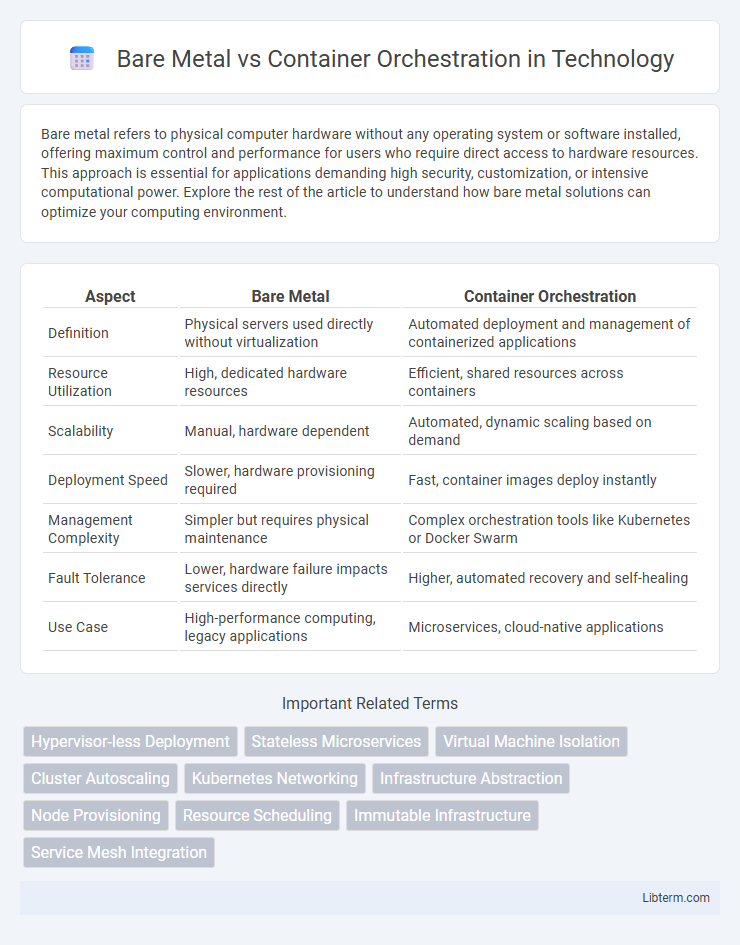Bare metal refers to physical computer hardware without any operating system or software installed, offering maximum control and performance for users who require direct access to hardware resources. This approach is essential for applications demanding high security, customization, or intensive computational power. Explore the rest of the article to understand how bare metal solutions can optimize your computing environment.
Table of Comparison
| Aspect | Bare Metal | Container Orchestration |
|---|---|---|
| Definition | Physical servers used directly without virtualization | Automated deployment and management of containerized applications |
| Resource Utilization | High, dedicated hardware resources | Efficient, shared resources across containers |
| Scalability | Manual, hardware dependent | Automated, dynamic scaling based on demand |
| Deployment Speed | Slower, hardware provisioning required | Fast, container images deploy instantly |
| Management Complexity | Simpler but requires physical maintenance | Complex orchestration tools like Kubernetes or Docker Swarm |
| Fault Tolerance | Lower, hardware failure impacts services directly | Higher, automated recovery and self-healing |
| Use Case | High-performance computing, legacy applications | Microservices, cloud-native applications |
Introduction to Bare Metal and Container Orchestration
Bare Metal servers provide direct hardware access without virtualization, delivering maximum performance and resource utilization for demanding applications. Container orchestration platforms like Kubernetes automate deployment, scaling, and management of containerized applications across clusters, improving efficiency and resilience. Understanding the distinctions between bare metal's low-level hardware control and container orchestration's automated management is crucial for optimizing infrastructure strategies.
Key Differences Between Bare Metal and Container Orchestration
Bare metal provides direct hardware access, offering maximum performance and resource control without virtualization overhead, whereas container orchestration platforms like Kubernetes manage containerized applications for scalable, automated deployment and operations. Bare metal environments require manual management of resources, scaling, and failover, while container orchestration automates service discovery, load balancing, scaling, and self-healing across distributed clusters. Security isolation differs as bare metal relies on physical separation, while container orchestration utilizes namespace and cgroup isolation within a shared OS kernel.
Performance Considerations: Bare Metal vs Container Orchestration
Bare metal environments offer superior performance by providing direct access to hardware resources without the overhead introduced by container orchestration layers. Container orchestration platforms, while enhancing scalability and management, introduce abstraction layers that may impact latency-sensitive applications. Selecting between bare metal and container orchestration depends on the balance between raw performance requirements and the operational flexibility needed for deployment and scaling.
Scalability and Flexibility in Infrastructure Deployment
Bare metal servers offer high-performance scalability by providing direct access to hardware resources, ensuring predictable and consistent workloads without virtualization overhead. Container orchestration platforms like Kubernetes enable flexible infrastructure deployment by automating container management, scaling applications dynamically across diverse environments, and facilitating rapid provisioning of resources. Scalability on bare metal requires manual resource allocation and provisioning, whereas container orchestration leverages declarative configurations and horizontal scaling for seamless adaptation to changing demands.
Security Implications of Bare Metal and Container Management
Bare metal environments offer enhanced security through complete hardware isolation, minimizing attack surfaces and reducing vulnerabilities associated with hypervisors or container runtimes. Container orchestration platforms introduce complexities such as shared kernel risks, container escape potentials, and the necessity for continuous monitoring of container registries and inter-container communications. Securing container management requires robust policies, vulnerability scanning, runtime protection, and strict access controls to mitigate threats inherent to multi-tenant, dynamically orchestrated infrastructures.
Cost Analysis: Total Ownership and Operational Expenses
Bare metal infrastructure incurs higher upfront capital expenses due to physical hardware procurement, while container orchestration platforms reduce total cost of ownership by optimizing resource utilization and enabling scalable multi-tenant environments. Operational expenditures for bare metal include maintenance, hardware upgrades, and downtime risks, whereas container orchestration lowers these by automating deployment, scaling, and recovery processes, thus reducing human intervention and associated labor costs. Organizations targeting cost efficiency benefit from container orchestration by leveraging pay-as-you-grow cloud-native models and minimizing wasted compute resources compared to fixed-capacity bare metal setups.
Use Cases: When to Choose Bare Metal or Container Orchestration
Bare Metal deployment is ideal for high-performance workloads requiring direct hardware access, such as big data analytics, machine learning, and latency-sensitive applications. Container orchestration excels in microservices architectures, enabling scalable, automated deployment and management of distributed applications in cloud-native environments. Choose Bare Metal for maximum hardware efficiency and container orchestration for flexibility, rapid scaling, and simplified management in dynamic infrastructures.
Management and Automation Capabilities Compared
Bare metal environments provide direct hardware access, allowing for highly customized management but often require manual configuration and limited automation compared to container orchestration platforms. Container orchestration tools like Kubernetes excel in automating deployment, scaling, and management of containerized applications through declarative configurations and APIs. These platforms offer advanced features such as self-healing, automated rollouts, and resource optimization, significantly enhancing operational efficiency over bare metal setups.
Challenges in Adopting Bare Metal or Container Orchestration
Challenges in adopting bare metal environments include limited scalability, complex hardware management, and slower deployment speeds compared to virtualized or containerized solutions. Container orchestration faces obstacles such as steep learning curves, security vulnerabilities due to multi-tenant environments, and difficulties in managing stateful applications across distributed clusters. Both approaches demand significant operational expertise and can incur higher initial costs, impacting enterprise agility and resource allocation.
Future Trends in Computing Infrastructure
Future trends in computing infrastructure indicate a growing shift from bare metal servers to container orchestration platforms like Kubernetes due to their scalability, resource efficiency, and faster deployment capabilities. Advances in edge computing, AI-driven automation, and hybrid cloud integration will amplify the adoption of container orchestration to manage distributed workloads seamlessly. Enhanced security measures and serverless computing models are also expected to influence the evolution of container orchestration, making it a cornerstone of next-generation infrastructure strategies.
Bare Metal Infographic

 libterm.com
libterm.com